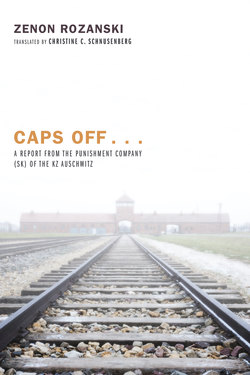Читать книгу Caps Off . . . - Zenon Rozanski - Страница 7
На сайте Литреса книга снята с продажи.
Foreword
ОглавлениеThroughout the entire world, Auschwitz has become known as the camp where bureaucratic, alarmingly and perfectly organized mass extermination of human beings found its abysmal culmination when the most modern means available at that time was applied: poison gas Zyklon B (hydrogen cyanide). For this reason, Auschwitz has become the symbol of the realization of the murderous ideology of National Socialism.
Less known, however, is the fact that the concentration camp Auschwitz had already existed since June 14, 1940 and that in its first epoch it was relatively small and detained primarily members of the Polish intelligentsia. Since spring 1942, however, people such as Jews, and later also Gypsies, were deported to Auschwitz only because they were “guilty”—in the eyes of the National Socialist Regime—of belonging to a “race” whose right to life that regime had denied: Once in Auschwitz, they were subjected to those infamous selections during which it was decided which of these deportees were to be marked as “fit for work” and therefore could be admitted as prisoners to the stock of the camp. This decision placed the prisoners in the armament industry where they were made available as a “human shield for production.” Those who were considered “unfit for work” were immediately murdered in one of the gas chambers.
Reports about these selections and about life in the shadows of the oversized crematories with their installed gas chambers have been translated into many languages. Courts had to deal with the mass murders for which the judicial system had no precedents available to impart justice in such a scope. For this reason, Auschwitz became a synonym for those crimes which differentiated National Socialism from all other Fascist regimes.
Less known is the first period of Auschwitz during which time this KZ was different from many others. It was different mainly because Poles had to live and die there. Reports written by Poles who had survived this period were rarely translated into other languages. Those who equate Auschwitz with the Holocaust, “the Final Solution of the Jewish Question,” as the Holocaust was called in bureaucratic German National Socialism, can overlook the fact that for many Poles Auschwitz remained in their collective memory a place of martyrdom for their nation.
The Pole Zenon Rozanski had to experience this first epoch in the history of Auschwitz. He was able to survive. After the liberation, he had the strength to describe this experience without any national blinkers. The SS sentenced him to a term of fifteen months in the Punishment Company (SK). Afterwards, he remained in Auschwitz and began to write in German a Report about the Punishment Company (SK) of the KZ Auschwitz, which he titled Mützen ab . . . In 1948, when this small book appeared, Auschwitz was a taboo topic in Germany. The edition may also have been limited perhaps because of paper scarcity, and therefore, Rozanski’s Report remained to a large extent unknown.
This situation might be regarded as characteristic of that time, when this subject was generally avoided because it would have confronted a generation with the question of what they had known at that time, what they had suspected, and how they themselves had acted. And it should not be considered atypical for the present time that, in contrast to the generation before them, the younger generation of Germans has now recognized the significance of this subject matter. One person of this generation has taken pains to make possible the new edition of Rozanski’s Report.
He deserves our gratitude for enabling future generations to learn about what was possible in the Punishment Company (SK) of Auschwitz, which was under the direction of the SS. “I limit myself, while writing down these facts”—that is, those happenings which he had to experience in the Punishment Company (SK)—“to a true photographic representation of a reality which still a short while ago determined my daily life,” wrote Rozanski in his introduction. Towards the end of his Report, he describes what Symek Rosenthal—a Jew from Cichenau—told him. In the summer of 1942, when the extermination machinery had already been constructed, Rosenthal had to “work” near one of the gas chambers. The Sonderkommando (special detachment) to which he was assigned had to haul out from a “room” the gassed corpses. At one time, it was the corpse of Rosenthal’s father.
The first period of Auschwitz passed into the next—the one which was to be designated as the “Final Solution.” Rosenthal cannot report to anyone. Rozanski has done it for him. He has experienced and survived Auschwitz. It is good that Mützen ab . . . is again available for reading.
Hermann Langbein
Vienna, June 1991
